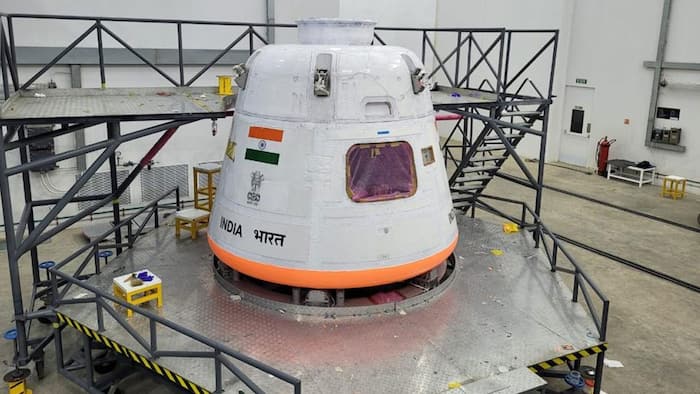
Written By Shweta Ganjoo
Published By: Shweta Ganjoo | Published: Oct 21, 2023, 01:37 AM (IST)

Gaganyaan Mission: The Indian Space Research Organisation (ISRO) is set to conduct the first test flight for its Gaganyaan mission on October 21. The mission called Flight Test Vehicle Abort Mission-1 (TV-D1) will commence at 8AM at the Satish Dhawan Space Centre (SDSC) in Sriharikota, during which time it will demonstrate the crew escape system. It is the first of the four such test flights planned by ISRO before the Crew Module (CM) that will house the astronauts for various space missions in the future is okayed for the final Gaganyaan mission. Also Read: Gaganyaan Mission Update: ISRO Plans Half-Humanoid Vyommitra Launch Before Astronauts
Before we understand, what this test flight means for India’s space ambitions, let’s first understand what is Mission Gaganyaan is. Also Read: PM Modi interacts with Bill Gates, talks about AI, UPI, India's digital revolution: Watch Video
ISRO’s Mission Gaganyaan aims to send a manned mission to the space and safely bring the astronauts back to Earth. According to ISRO, mission Gaganyaan aims to demonstrate India’s human spaceflight capability by launching crew of three members to an orbit of 400Km for a three-day-long mission and then bring them back safely to earth, by landing in Indian sea waters. Also Read: ISRO to launch INSAT-3DS satellite today: Top things to know
Mission Gaganyaan will use a special version of ISRO’s LVM3 launch vehicle dubbed as the Human Rated LVM3 (HLVM3) to launch the astronauts and the additional payload to the space and bring them back safely. It will have several important parts that will together during the mission. Here are the details:
— First is Orbital Module that will take the astronauts to the Low Earth Orbit (LEO) of 400Km and them bring them back to the earth.
— The Orbital Module or OM will comprise of Crew Module (CM) and Service Module (SM)
— The Crew Module (CM) that will house the astronauts.
Now, CM is the habitable space with Earth like environment in space for the astronauts. It will house the crew interfaces, human centric products, life support system, avionics and deceleration systems. It is not only designed to take astronauts to the space but also enable them to re-entry the earth’s atmosphere while ensuring safety of the crew during descent till touchdown.
— Service Module or SM will provide necessary support to CM while in orbit. ISRO describes it as an unpressurised structure containing thermal system, propulsion system, power systems, avionics systems and deployment mechanisms.
— Another important part of the mission is the Crew Escape System (CES), which will be powered by a set of quick acting, high burn rate solid motors that will ensure that Crew Module along with crew is taken to a safe distance in case of any emergency either at launch pad or during ascent phase.
The Test Vehicle Abort mission-1 (TV-D1) is one of the major tests being conducted by ISRO and it will test the preparedness of the Crew Module or the CM. “The CM in this mission is extensively instrumented to capture the flight data for evaluation of the performance of various systems. The Crew Module will be recovered after touchdown in the Bay of Bengal, using a dedicated vessel and diving team from the Indian Navy,” ISRO wrote in a post on its official website.
Saturday’s Test Vehicle will use a single-stage liquid rocket that has been specially developed for this abort mission. The payloads that the test vehicle will include will consist of the Crew Module (CM) and Crew Escape Systems (CES) with their fast-acting solid motors, along with CM fairing (CMF) and Interface Adapters.
Mission Gaganyaan:
TV-D1 Test FlightThe test flight can be watched LIVE
from 0730 Hrs. IST
on October 21, 2023
at https://t.co/MX54CwO4IUhttps://t.co/zugXQAYy1y
YouTube: https://t.co/75VtErpm0H
DD National TV@DDNational#Gaganyaan pic.twitter.com/ktomWs2TvN— ISRO (@isro) October 19, 2023
Simply put, this flight will simulate the abort condition during the ascent trajectory corresponding to a Mach number of 1.2 that the Gaganyaan Mission will encounter during its flight. During the test flight, CES with CM will be separated from the Test Vehicle at an altitude of about 17Km. After that, the abort sequence will be executed beginning with the separation of CES and deployment of the series of parachutes before ensuring a safe touchdown of CM in the sea, which will be about 10Km from the coast of Sriharikota.
Significance
Saturday’s test will be a significant milestone for the overall Gaganyaan mission. The success of this test flight will set the stage for the remaining qualification tests and unmanned missions, leading to the first Gaganyaan mission with Indian astronauts.
The successful completion of the Flight Test Vehicle Abort Mission-1 (TV-D1) will ensure that ISRO remains on track for the Gaganyaan mission, which is expected to launch in 2025. It will essentially demonstrate India’s capability to take humans to space and potentially open gateways for space tourism.
ISRO’s Gaganyaan mission will also pave way for ISRO to launch and deploy Bharatiya Antariksha Station or Indian Space Station by 2035 and send the first manned mission to the Moon by 2040.